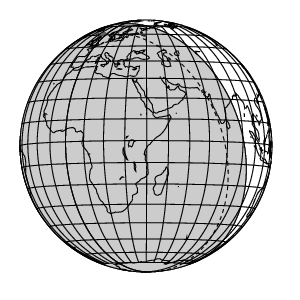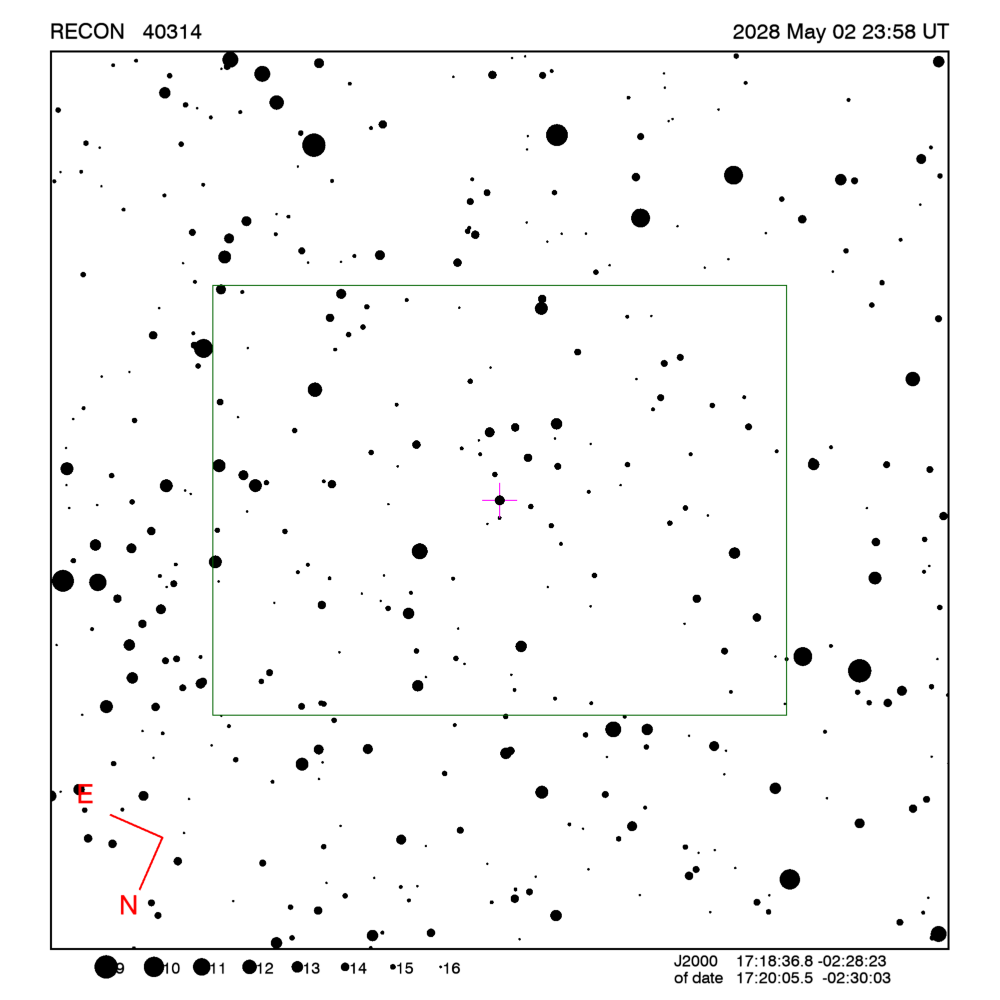RECON: TNO occultation with 40314
Event between (40314) 99KR16 and star GA0860:05472522
with event index number of 2309631
Geocentric closest approach at 2028/05/02 23:54:08 UTC
J2000 position of star is 17:18:36.8 -02:28:23
Equinox of date position of star is 17:19:53.5 -02:29:50
Stellar brightness G=14.3,
use SENSEUP=64 with the MallinCam and and exposure
time of 1 seconds with the QHY174 camera.
Star is 113 degrees from the moon.
Moon is 60% illuminated.
Apparent brightness V=21.0
 Object is 34.0 AU from the Sun
and 33.2 AU from the Earth.
Object is 34.0 AU from the Sun
and 33.2 AU from the Earth.
Apparent velocity is 19.5
km/sec on the sky relative to the star, or,
2.9 arcsec/hr.
The 1-sigma error in the time of the event is 102 seconds.
The 1-sigma cross-track error in the shadow position is
1333 km.
The object has an absolute magnitude Hv=5.6
Diameter=436.5 km assuming a 5% albedo -- 23.2 sec chord
Diameter=178.2 km assuming a 30% albedo -- 9.5 sec chord
Dynamical classification is SCATNEAR
Star training set for 40314, (2028/05/02 23:58UT)
Object RA Dec mag sep mel
Antares 16:31:09.0 -26:29:32 0.9 26.71 105
60Bet Oph 17:44:52.4 +04:33:26 2.8 9.39 118
PPM 180059 17:27:26.2 -01:40:28 6.4 2.01 115
PPM 200555 17:20:50.3 -02:46:36 7.4 0.33 114
PPM 200551 17:20:42.8 -02:37:28 9.8 0.20 114
PPM 200546 17:20:16.8 -02:40:39 10.1 0.18 113
40314 17:20:05.5 -02:30:03 14.3 114
Positions are for equinox of date

Azimuth is measured in degrees eastward from north.
North is at an azimuth of 0, due East is at an azimuth
of 90 degrees, due South is 180, and due West is 270.
Do not use the listing below for the RECON CPC 1100 telescopes.
This is provided for other non-team facilities.
Star training set for 40314, (2028/05/02 23:58UT)
Object RA Dec mag sep mel
Antares 16:29:24.4 -26:25:56 0.9 26.71 105
60Bet Oph 17:43:28.3 +04:34:06 2.8 9.39 118
PPM 180059 17:25:58.0 -01:39:05 6.4 2.01 115
PPM 200555 17:19:21.3 -02:44:57 7.4 0.33 114
PPM 200551 17:19:13.9 -02:35:49 9.8 0.20 114
PPM 200546 17:18:48.0 -02:38:59 10.1 0.18 113
40314 17:18:36.8 -02:28:23 14.3 113
Positions are for J2000
Event circumstances last updated at 2024/06/24 21:28:47 UT
Marc W. Buie,
Southwest Research Institute
RECON
 Object is 34.0 AU from the Sun
and 33.2 AU from the Earth.
Object is 34.0 AU from the Sun
and 33.2 AU from the Earth.
